
The Best Mortars and Pestles of 2020
Share
 — Recommendations are independently chosen by Reviewed’s editors. Purchases you make through our links may earn us a commission.
— Recommendations are independently chosen by Reviewed’s editors. Purchases you make through our links may earn us a commission.If you have a food processor or spice grinder, you might not think you need a mortar and pestle, like our top pick, the Frieling Cilio Goliath Mortar and Pestle (available at Amazon for $59.99).
In some ways, you could be right: Modern electrical appliances can do everything this ancient tool can do, faster and without the extra elbow grease. But are you sacrificing flavor by tossing pesto ingredients into a food processor, and can you get more out of spices like peppercorns and coriander seeds if you crush them by hand? After testing nine of the best mortars and pestles, we can say that the food we made in these hand-powered tools had an extra-special quality to them. Doing things the old-fashioned way and crushing the ingredients (instead of cutting them with a blade) released more flavors and aromas, resulting in a better-tasting product.
That said, not all the mortars and pestles could handle the tasks we threw at them. In fact, some were extremely frustrating to use and we could only manage it for a limited amount of time. Some were also lacking a rough enough interior to pulverize spices or create a paste. Others had too-short pestles that rubbed our palms uncomfortably against the bowl as we used them. The ones that exhibited the best results and were the easiest to use were made from granite, but we also had a few favorites made from stoneware and marble that doubled as gorgeous serving bowls.
Here are the best mortars and pestles we tested ranked, in order.
- Frieling Cilio Goliath Mortar and Pestle
- ChefSofi Mortar and Pestle
- Laevo Reversible Marble Mortar and Pestle
- Emile Henry Mortar and Pestle
- Le Creuset Mortar and Pestle
- Gramercy Kitchen Co. Mortar and Pestle
- Vasconia 4-Cup Granite Molcajete
- Cooler Kitchen EZ-Grip Silicone and Porcelain Mortar and Pestle
- NewlineNY Stainless Steel Hand Masher and Bowl
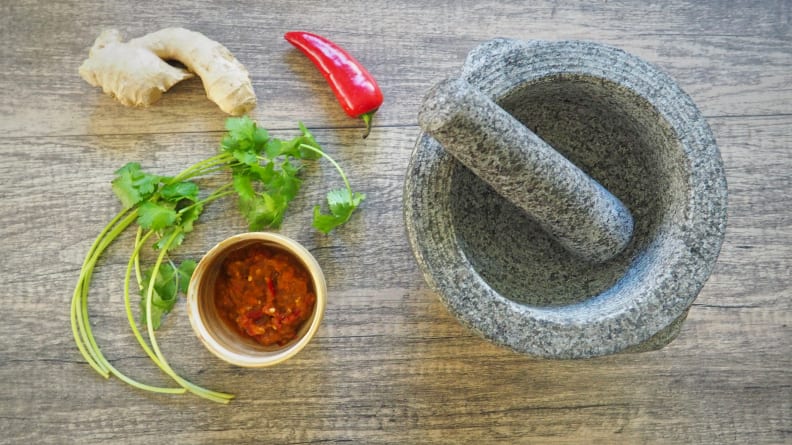

Granite mortar and pestles are heavy and sturdy, and this one made quick work of every task we threw at it.
When it comes to performance and design, the Frieling Cilio Goliath Mortar and Pestle had it all. This mortar and pestle is seriously heavy-duty: weighing in at a massive 14.5 pounds, this unit was significantly heavier than any other model we tested. It didn’t even think of sliding around on the counter as we used it! That heft also helped it make quick work of everything we threw at it; the heavy pestle basically did most of the work for us, turning peppercorn into dust in seconds and pulverizing garlic cloves into a fine paste. In fact, it tackled every test with ease, from herbs and seeds to transforming basil leaves into pureed pesto and chili peppers into curry paste.
The design was well thought out, too. The pestle’s wide and rounded bottom helped it crush and grind, but the tapered top was comfortable to hold. It was also sufficiently tall, so we could grip the top of the pestle without rubbing our hands against the side of the mortar. The tall sides of the mortar bowl kept food from escaping, and it could hold about three cups of liquid (or enough guacamole to feed a crowd!). We were also happy with the appearance of the set, and it looked nice enough that you could bring the entire bowl to the table when serving guests. The only downside? We mentioned it’s massive and heavy, which makes moving and storing the bowl more difficult than some of the smaller models. It was also a bit of a pain to clean and remove the contents from the bowl, but we think that’s worth it considering how it absolutely aced all of our tests.
Put it all together, and the Frieling Cilio Goliath Mortar and Pestle was a shoo-in for our pick as Best Overall. If you’re looking for the absolute best mortar and pestle available, and you don’t mind its large, heavy profile, this is the one for you.
Pros
-
Pulverizes food quickly
-
Tall sides
-
Pretty enough to display
Cons
-
Difficult to move around or store
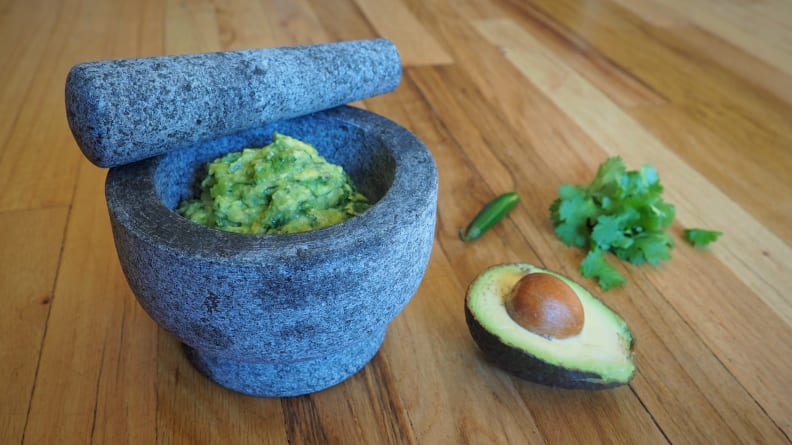

This granite mortar and pestle performed just as well as our winner, available at a fraction of the cost.
The ChefSofi Mortar and Pestle performed just as well as our top pick, but it’s available for a fraction of the cost. It’s also smaller and lighter, clocking in at a still-impressive 7 pounds. Between the weight and the non-slip pad at the base of the mortar, we were pleased to see that this bowl didn’t move around as we used it. The pestle was more than large enough, too—it’s just as tall as our winning set, but the mortar bowl is much lower. That gave us more than enough room to keep our hands free from rubbing against the sides. That extra clearance also gave us plenty of leverage when it came to crushing seeds and pureeing herbs.
At first, we were worried that the smaller size might not be big enough. We were proven wrong as soon as we started the tests; the two-cup capacity of the bowl is more than sufficient to make a two-avocado guacamole or a four-serving batch of pesto. The inside of the bowl was smoother than our top pick, too, but it was rough enough to create pastes and purees without issue. It’s also worth noting that this model does require an initial seasoning—grinding up white rice to remove any granite bits that may be leftover from the manufacturing process. Luckily, you only need to season it once, and grinding up that rice is a great way to practice and get to know your new mortar and pestle!
In the end, it’s a well-performing, heavy-duty mortar and pestle that’s big enough—but not too big. As a bonus, you don’t have to spend a fortune to get it, which makes it a no-brainer to name this one as our Best Value pick.
Pros
-
Includes a nonslip pad
-
Tall pestle
-
Inexpensive
Cons
-
Needs to be seasoned prior to the first use
How We Tested

We tested a variety of mortars and pestles in all shapes, sizes, and materials, including granite, stoneware, ceramic, marble, and stainless steel.
The Tester
Hi, I’m Lindsay Mattison, a trained professional chef and a from-scratch proponent. If I can grind a pork shoulder to make sausage or simmer tomatoes all day long for a world-class sauce, I will! That’s not to say I take shortcuts from time to time, but I always grind dry spices by hand in a mortar and pestle. It’s also great for making pastes, sauces, dips, and more, and I’d love to help you find one that ignites your passion for making handmade food.
The Tests
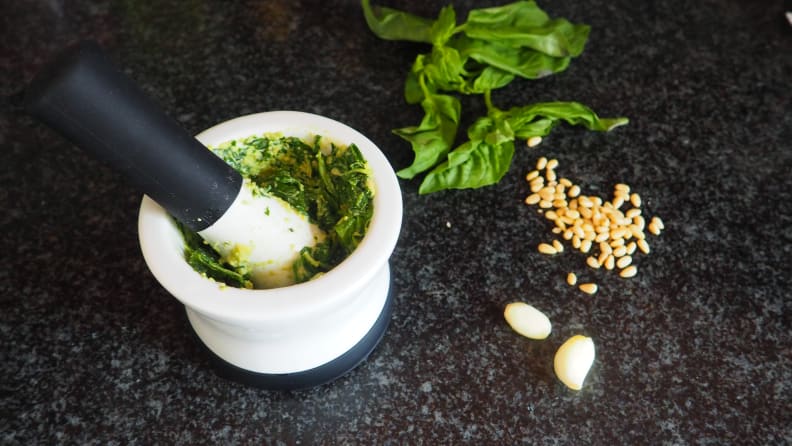
Mortars and pestles can be used for so much more than grinding spices. Use it to make dips, sauces, pesto, salad dressings, baby food, and more!
Our tests for the mortar and pestle were twofold: Test how it could handle grinding spices like peppercorns and seeds, and see if it could mash the fibers of ingredients to create pastes and purees. We started by testing a teaspoon of peppercorns and a tablespoon of fennel seeds in each mortar and pestle. The successful models not only ground the seeds into dust, but they did so quickly and without spilling out the edges of the bowl. From there, we got to work making a paste out of garlic, which we later turned into a four-serving batch of pesto by adding basil leaves, pine nuts, olive oil, and finely grated cheese. We also made a batch of guacamole, which allowed us to see how the pestle could handle slippery avocado. To finish, we pulverized onion, garlic, ginger, cilantro stems, dried and fresh chili peppers, and lemongrass, looking for the models that could turn this mixture of loose ingredients into a fine paste.
All the while, we were evaluating the mortar and pestle’s material along with its size, shape, capacity, and overall ease of use. Did the mortar have rough ridges to break down the food’s fibers, and was the pestle heavy enough to do most of the work for us? Did our hands and wrists tire after the tests, and did the pestle have an ergonomic grip? Was the pestle long enough or did our hands rub against the side of the mortar as we used it? As a final testing note, we assessed whether the mortar and pestle were large enough to handle all the tasks we threw at it. In the end, we found that some materials and sizes simply worked better than others.
What You Should Know About Mortars and Pestles
Every task you can throw at a mortar and pestle can be done—more hands-off and faster—by an electrical appliance. Food processors or blenders can make pesto and curry paste, and spice grinders can turn hard peppercorns into a pile of dust in a matter of seconds. You can even make things like guacamole without any extra tools—just chop your ingredients and combine them with a fork in a regular old bowl.
So why invest in a mortar and pestle? It’s traditional, and it preserves the way food was made for hundreds of years. Before electricity, how do you think curry paste was made? In a mortar and pestle. How about crushing spices to add pungent flavor and fresh aromas to soups and stews? Yup, you guessed it, the mortar and pestle. What makes this device so special is its ability to crush food and mash plant fibers until they’re as soft as a puree. When we compared hand-made pesto in the mortar and pestle with the one we made in a blender, the difference was night and day. Our hard work and elbow grease produced a sauce that had more flavor and aroma as compared to the one made with the stainless steel blades of the blender. Even guacamole tasted better—crushing the onion, garlic, and cilantro before adding the avocado brought out essential oils and flavors that weren’t detectable in our fork-mashed version.
Once you have a mortar and pestle, you'll use it for so much more than grinding spices. Pull it out the next time you make salad dressings or dips; use it to crush fresh herbs to release their essential oils; you can even pulverize fruit for pie filling or baby food. The possibilities are endless!
What to Look For in a Mortar and Pestle
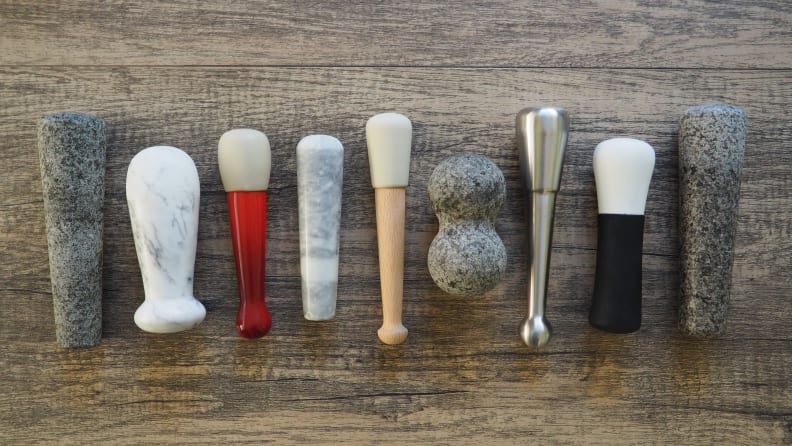
Pestle size and shape makes a big difference when it comes to comfort and ergonomics.
Not all of the mortars and pestles passed our tests. The stainless steel model wasn’t able to do much more than crush peppercorns, and the marble and stoneware versions didn’t have a rough enough interior to fully pulverize fresh and dried chilies into a paste.
When looking for a mortar and pestle, the first thing to look at is the pestle weight, size, and shape. If it’s not comfortable to use, it doesn’t matter how effective it is, so it’s worth being picky in this department. Too-short pestles forced our hands into the mortar, scraping them against the sides, and ones without broad bottoms seemed to push food around the inside without actually crushing it. When you’re looking at the setup, you want the pestle to stick out of the bowl a few inches. Ideally, it’s also rounded on the top so it won’t dig uncomfortably into your palm as you use it. It’s also good if it’s heavy—that means it will do a lot of the crushing for you!
From there, you want a mortar that’s not polished on the inside. The more rough grooves it has, the better; these grip onto the food and help obliterate the fibers to create a paste or puree. Stoneware and marble mortars and pestles have lightly rough insides, but the granite models seemed to do the best job at gripping and ripping. They also felt the sturdiest, not moving around as much as we used them, and we weren’t afraid they might crack and chip like ceramic.
The final factor is bowl shape and size. Mortars that were too wide don’t have adequate rims to keep the food from spilling out as you crush it. This becomes especially problematic with tiny little peppercorns, which just love jumping around on the countertops. When it comes to size, it’s really up to you to decide how you’ll use it. If you cook for a crowd and you want plenty of extra space, go for a mortar with a four-cup capacity. A two-cup mortar and pestle works just fine for most tasks, and anything smaller than that can likely only handle crushing small amounts of nuts or seeds.
Other Mortars and Pestles We Tested

When it came to overall score, the Laevo Reversible Marble Mortar and Pestle actually tied with our winning granite pick. This marble mortar and pestle set was well-designed and functional, and it looked great doing it. It came with a non-slip pad, which kept the bowl from sliding around as we used it. The pestle had a comfortable grip, and it was heavy enough to do most of the grinding work for us. The inside of the mortar was rough enough to crush peppercorns into a fine powder and turn garlic into a paste, and its two-cup capacity was large enough to fit a batch of pesto. As a bonus, the mortar doubles as a really beautiful serving bowl for guacamole! Our winning pick just edged this one out because it made a better-looking curry paste out of the chili peppers. But, if our winning pick is out of stock or you are specifically looking for a marble mortar and pestle, this is the one for you.
Pros
-
Looks great
-
Includes non-slip pad
-
Comfortable grip
Cons
-
None that we could find

There was a lot to like about the Emile Henry Mortar and Pestle. The ceramic mortar was glazed on the outside but had an unglazed, nonporous interior. It was just rough enough to mash garlic into a paste and grind peppercorns. Without ridges inside, this mortar and pestle struggled to turn peppercorns into as fine a powder as its granite competition, and it couldn’t turn chili peppers into curry paste either. But the thing we really loved about the Emile Henry was its smart design. The 2-cup capacity bowl had tall edges to keep food from splashing out, and the four-corner design made it easy to grip. That’s an important feature since the bowl wasn’t heavy enough to stay put on its own as we used it. The wooden-handled pestle was also extremely comfortable, and the whole thing looks nice enough to double as a serving bowl. It's dishwasher safe, too!
Pros
-
Smart design
-
Pestle comfortable to use
-
Easy to grip
Cons
-
Can't compete with granite-styles

If having a showpiece is more important than having a completely functional mortar and pestle, the Le Creuset Mortar and Pestle won’t disappoint. We didn’t have any complaints about the pestle, and the 20-ounce stoneware mortar was large enough to handle every task we threw at it. The wide, tapered edges did a great job at keeping the peppercorns from flying out as we crushed them, too. Unfortunately, it doesn’t have any ridges on the interior, and we had trouble transforming whole spices into a very fine grind. It did just fine on pesto and guacamole, but it wasn’t rough enough inside to turn peppers into a fine paste. In the end, we’d say it’s good for most tasks, but not all of them.
Pros
-
Beautiful
-
Wide tapered edges
-
Large bowl
Cons
-
Bowl lacks inside ridges

The Gramercy Kitchen Co. Mortar and Pestle is a gorgeous marble mortar and pestle that would look great on any countertop. It featured smooth marble on the outside and grooved, slightly rough edges on the interior. When it came to performance, though, this wouldn’t be our top pick. It had tall edges, so nothing spilled out as we used it, but we’re not sure it actually has a full two-cup capacity. It was just barely big enough to make our batch of pesto, and a one-avocado guacamole completely filled the bowl. Where it really fell short was the pestle, which wasn’t long enough and caused our fist to rub uncomfortably against the side of the mortar.
Pros
-
Tall sides
-
Made of beautiful marble
Cons
-
Mortar was too small inside
-
Pestle too short

At first glance, we thought we were going to love the Vasconia 4-Cup Granite Molcajete. It’s not quite as heavy as our top pick, but it has the same rough interior. Where the Vasconia lost most of its points was around the product design. It was shorter and wider than any of the mortars and pestles we tested, which created low edges that had us chasing spilled peppercorns all over the counter. When making pesto, the wide bowl prevented a mass of leaves from coming together, making it nearly impossible to emulsify the sauce and bring it into a cohesive mix. The short, squat pestle was also extremely uncomfortable, and it hurt our wrist after making pesto or curry paste. All in all, we’d rather go with one of the other granite options.
Pros
-
Rough interior
Cons
-
Poor design

We liked the sleek black-and-white look of the Cooler Kitchen EZ-Grip Silicone and Porcelain Mortar and Pestle, but it wasn’t our favorite when it came to performance. The porcelain interior was too smooth inside, so we had trouble even crushing peppercorns in this model. We also found it difficult to grip the bowl as we used it, and it was lightweight enough that it slid around during use (even with the silicone base). Add the fact that it was a touch too small for our liking, and this one fell to the bottom of our list. The one-cup capacity could barely fit a whole avocado.
Pros
-
Sleek looking
Cons
-
Too smooth inside bowl
-
Difficult to grip
-
Too small
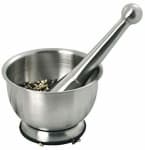
Sadly, we didn’t have anything good to say about the NewlineNY Stainless Steel Hand Masher and Bowl. This stainless steel mortar and pestle is completely smooth, which made it difficult to crush everything from peppercorns to basil leaves. It also didn’t create any grip, so the crushed garlic sort of spread around everywhere instead of making a paste. Even the avocados slid right out of the bowl when we tried to mash them! Considering that this model is no less expensive than most of the mortars and pestles on this list and it didn’t succeed on most of our tests, we’re going to give it a pass.
Pros
-
None that we could find
Cons
-
Couldn't crush anything
-
Avocados slid out of the bowl